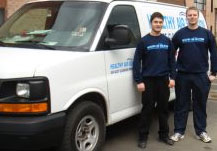Frequently asked questions:
What is air duct cleaning?
Very often the two terms “air duct cleaning” and “indoor air pollution” are inextricably connected. In fact, duct cleaning has evolved in response to the increasing concerns over indoor air pollution. Most indoor air quality (IAQ) problems are a combination of many factors, the physical condition of the heating, ventilation, and air conditioning (HVAC) system being one of them. Duct cleaning generally refers to the cleaning of various heating and cooling system components of forced air systems, including the supply and return air ducts and registers, grilles and diffusers, heat exchangers heating and cooling coils, condensate drain pans (drip pans), fan motor and fan housing, and the air handling unit housing.
How can I tell if my air ducts need cleaning?
The best way to check if your air ducts are dirty is to look inside the duct. Open up the furnace and look at the blower motor or look at the return duct. You would probably be shocked at the amount of dirt and debris that has buildup in your air duct system.
Will there be a mess in the house when you clean my air ducts?
We guarantee no mess. The duct system is placed under negative pressure (suction) with our powerful vacuum equipment during the cleaning process so there is no dust going into the house.
How often should I change my furnace air filter?
One-inch disposable air filters should be changed monthly. 4-inch air filters should be replaced every 3-4 months. Do not operate your furnace or air conditioning system without an air filter, even if you are running to pick up a new one! The system will not have any protection from dust and debris.
Will a clean air duct system result in lower energy costs?
In a dirty air duct system energy consumption could be increased depending on the amount of contamination and its location. If the fan blades, evaporator coil or other control components of the system are heavily contaminated, the system may have to run much longer to cool or heat the house, wasting a lot of energy and money. Clean HVAC System will operate more efficient.
How often should I have my air ducts cleaned?
Once an air duct system is thoroughly cleaned, it should remain clean for 2 to 4 years (depending on the environment) if properly maintained. Customers who have the following might also want to consider more frequent cleanings:
- Commercial building owners due to higher human traffic.
- Pets that shed high amounts of hair and dander.
- Water contamination or damage to the home or HVAC and air duct system.
- Residents with allergies or asthma who might benefit from reduction in the amount of indoor air pollutants in the home’s HVAC system and air passages.
- After home renovations or remodeling.
- Prior to occupancy of a new home.
What kind of equipment is best for air duct cleaning – truck mounted vacuums or portable?
NADCA does not endorse one kind of equipment over another. There are two main types of dust collection devices: mounted on trucks and portable units. Truck mounted equipment is generally more powerful than portable. However, portable equipment would be brought directly into the house, allowing the vacuum source to be located closer to the ductwork so it won’t lose any suction pressure because of long hoses. Both types of equipment will clean to NADCA standards.
How often should I have my chimney cleaned?
Generally, if you use wood, it is good to have the chimney inspected at least every 6-12 months (more often if you burn two or more cords of wood, or if you burn green wood).
I heat with gas. Should this chimney be checked too?
Without a doubt! Although gas is generally a clean burning fuel, the chimney can become non-functional from bird nests or other debris that block the flue.
Will there be a mess at my house after chimney cleaning?
No. We use a powerful vacuum that prevents soot and dust from entering the home, and we are careful to take precautions in order to prevent any mess.
What are the warning signs that dryer vent needs cleaning?
The symptoms may include:
- Clothes take longer and longer to dry;
- Clothes don’t fully dry;
- Clothes are hotter than normal at the end of the drying cycle;
- The outside of the dryer gets very hot;
- The outside exhaust vent flapper does not open very much indicating low exhaust velocity;
- Laundry room becomes more humid than it is usually;
- Burnt smell evident in the laundry room.




